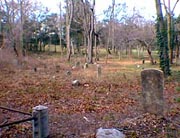
Any Rikers & Hart Islands'
Civil War U.S. Colored Troops
In Once-Overgrown LI Cemetery?
That's one of the questions which a coalition of African-American
church members, students and teachers from nearby Friends Academy, civic
workers, local public officials and the Oyster Bay Historical Society hopes
will be answered as the result of a resortation and research project underway at Youngs Cemetery.
Win Himsworth, a member of the Youngs Cemetery Restoration
Committee, wrote about the project in The Freeholder, The History Magazine
of the Town of Oyster Bay, published quarterly by the Oyster Bay Historical
Society.
The New York Correction History Society presents here,
by the author and publisher's permission, his report. Those interested
in participating in the project should contact the Oyster Bay Historical
Society. Contact information appears below.
The Youngs Cemtery photos that accompany the text were
taken by the New York Correction History Society specifically to illustrate
this web presentation. No individual identifable gravestones were photographed.
 Restoring
and Researching Youngs Cemetery: Restoring
and Researching Youngs Cemetery:
A Part of African-American Civil War History
By Win Himsworth
Youngs Cemetery Restoration Committee
On the west side of Piping Rock Road, between Frost Pond and Duck Pond
Roads, lies a two-acre piece of Civil War history camouflaged by trees
and heavy underbrush. In recent years, the property has been identified
only by an old roadside split rail fence with a small faded American flag
and an equally small plaque reading "YOUNGS CEMETERY – Civil War Veterans
Buried Within." Work is now slowly underway to restore this cemetery and
to research its historical roots.
Beginning this Spring [1999], thanks to the efforts of a group of students from nearby Friends Academy, a portion of the underbrush has been cut back to reveal a series of old gravestones and plots. Many more can be found by working back into the overgrown area further from the road. The oldest legible stones mark the graves of individuals born during the Civil War era. Still older, and virtually illegible, stones mark the graves of earlier generations. A listing in the Oyster Bay Historical Society’s records notes that the cemetery is believed to be of Colonial origin and that some of the last local Indians were buried there.

Old maps of the area indicate that the property was owned by the Youngs
family as late as 1873. Apparently shortly thereafter the property was
donated to what is now the Calvary African Methodist Episcopal Church of
Glen Cove as a cemetery for Civil War era African-Americans.
One interesting question yet to be researched is how many African-American Civil War veterans are buried in Youngs Cemetery. Interest in the history of African-Americans fighting in the Civil War received a big boost last year with the dedication of the African-American Civil War Memorial in Washington, D.C., to honor the soldiers of the United States Colored Troops. Approximately 180,000 USCT soldiers served in the Union Army (and many more in the Union Navy) representing about 10% of total Union forces. In the New York area, more than 4,000 African-Americans served in the USCT’s 20th, 26th, and 31st infantry regiments. These regiments were organized on Rikers Island and Harts Island that drew recruits from the surrounding areas likely to include Oyster Bay.
Mrs. Alberta Hersey, who was a member of the Calvary A.M.E. Church,
traced her congregation’s roots back to the 1700s when fugitive slaves
began travelling north. Those arriving in this area were befriended and supported by the Quakers
who had established their Friends Meeting House on Duck Pond Road in 1725,
just down the road from Youngs Cemetery.
Those arriving in this area were befriended and supported by the Quakers
who had established their Friends Meeting House on Duck Pond Road in 1725,
just down the road from Youngs Cemetery.
The Church itself was founded sometime in the late 1700s or early 1800s,
originally as the African Methodist Church of Cedar Swamp. By the time
of the Civil War, a simple wooden church had been erected on Dosoris Lane.
Restoration of the Youngs Cemetery grounds and gravestones is a necessary first step in reestablishing the dignity of the cemetery and in researching its history.
NYCHS encourages those interested in obtaining more information and possibly participating in the Youngs Cemetery project to contact: | |
Headquartered in its historic Earle-Wightman House museum and library,
the Society provides tourists, students, scholars, and historians
with craft exhibits, lectures, maps, photos, historical and genealogical
documents.
The Oyster Bay Historical Society
P.O. Box 297, 20 Summit Street
Oyster Bay, New York 11771-0297
Thomas A. Kuehhas, Director
Edward B. (Woody)
Ryder IV, President
Telephone: (516) 922-5032
Faxphone: (516) 922-6892
web site: http://members.aol.com/obhistory
Email: OBHistory@aol.com
|
The restoration process is complicated by years of neglect, the limited
resources of the Church, and divided political jurisdictions. An earlier
Church fire, that destroyed all burial records, will make the historical
research phase more difficult and will require reliance on alternative
genealogical sources.
Fortunately, a growing coalition of community groups — including the
Calvary A.M.E. Church, Mayor Souzzi of Glen Cove, the Matinecock Neighborhood Association, Friends Academy, the Oyster Bay Historical Society, and various other volunteer groups — is banding together to attract restoration and research efforts. Members and friends of the Oyster Bay Historical Society wishing to participate in the challenging Youngs Cemetery Historical project should contact the Society.
|


 Restoring
and Researching Youngs Cemetery:
Restoring
and Researching Youngs Cemetery:

 Those arriving in this area were befriended and supported by the Quakers
who had established their Friends Meeting House on Duck Pond Road in 1725,
just down the road from Youngs Cemetery.
Those arriving in this area were befriended and supported by the Quakers
who had established their Friends Meeting House on Duck Pond Road in 1725,
just down the road from Youngs Cemetery.